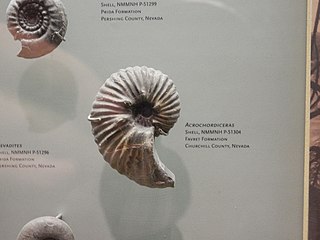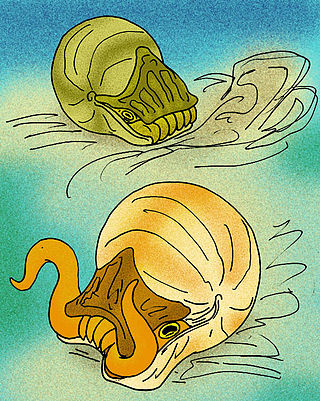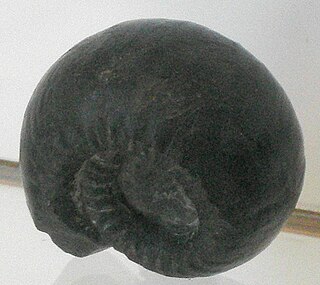
Acrochordiceras is a genus of Middle Triassic ammonoid cephalopods belonging to the ceratitid family Acrochordiceratidae, included in the superfamily Ceratitoidea.

Arcestes is a genus of extinct ceratitid ammonites found in Triassic-aged marine strata.

Ceratitida is an order that contains almost all ammonoid cephalopod genera from the Triassic as well as ancestral forms from the Upper Permian, the exception being the phylloceratids which gave rise to the great diversity of post-Triassic ammonites.
Adrianitoidea is one of seventeen superfamilies currently included in the Goniatitina, but only one of six there included in the Treatise, 1957. Shells are subdiscoidal to globose with variable umbilici and sutures with 10 to 30 lobes, which tend to be subequal.
Cheiloceratidae is a family of ammonoid cephalopods included in the goniatitid suborder Tornoceratina in which the suture has 4 to 12 lobes, the ventral one undivided and those in the lateral areas originating as subdivisions of internal and external lateral saddles.
The Posttornoceratidae are Late Devonian goniatites (Ammonoidea) included in the superfamily Tornoceratoidea. The family, Posttornoceratidae, named by Bogoslovsky in 1962, is based on the genus Posttornoceras, named by Wedekind in 1910, originally included in the Tornoceratidae.
Dimorphoceratoidea is one of seventeen superfamilies included in the ammonoid suborder Goniatitina, a variety of shelled cephalopods that lived during the late Paleozoic.

Gastrioceratoidea is one of 17 superfamilies in the suborder Goniatitina, ammonoid cephalopods from the Late Paleozoic.

Goniatitoidea, formerly Goniatitaceae in older publications, is a superfamily of late Paleozoic ammonoid cephalopods included in the Goniatitida. They are characterized by thinly discoidal to globular shells with variable umbilici and sculpture. The ventral lobe, located along the outer margin, is prominently bifurcated ; the lateral lobe undivided.
Thalassoceratoidea, formerly Thalassocerataceae, is a superfamily of Late Paleozoic ammonites characterized by their thick-discoidal to subglobular, involute shells with narrow or closed umbilici and biconvex growth striae with ventral sinuses. The ventral lobe of the suture, which straddles the outer rim, is wide, and bifid, with a tall median saddle.
Adrianitidae is a family in the Adrianitaceae, a superfamily of ammonites in the cephalopod order, Goniatitida, known from the Middle Pennsylvanian to the Middle Permian.

Goniatitinae is one of six subfamilies into which the Goniatitidae is subdivided according to Miller, Furnish, and Schindewolf, 1957. The diagnostic character is the narrow bifurcated ventral lobe of the suture, which lies along the outer rim. As with the inclusive Goniatitidae, sutures have eight lobes, shells are without prominent ornament, umbilici are small to moderate in size.
Thalassoceratidae a family of late Paleozoic ammonites included in the goniatitid superfamily Thalassoceratoidea along with the Bisatoceratidae. Some eight genera are included, although the specific number and exactly which depends on the particular classification.

Prolecanitida is an order of extinct ammonoid cephalopods, the major Late Paleozoic group of ammonoids alongside the order Goniatitida. Prolecanitids had narrow shells, discoidal (disc-shaped) to thinly lenticular (lens-shaped). They retained a retrochoanitic siphuncle, a simple form with septal necks extending backwards. As is typical for ammonoids, the siphuncle sits along the ventral margin of the shell.

Prolecanitoidea is a taxonomic superfamily of ammonoids in the order Prolecanitida. Prolecanitoidea is one of two superfamilies in the order, along with the younger and more complex Medlicottioidea. The Prolecanitoidea were a low-diversity and morphologically conservative group. They lived from the Lower Carboniferous up to the Middle Permian. Their shells are generally smooth and discoidal, with a rounded lower edge, a moderate to large umbilicus, and goniatitic to ceratitic sutures. Suture complexity varies from 10 up to 22 total lobes ; new lobes are added from subdivision of saddles adjacent to the original main umbilical lobe.

The Medlicottioidea is one of two superfamilies that make up the Prolecanitida, the other being the Prolecanitoidea.
Pachylyroceras is a large, generally subglobular, Upper Mississippian gonitite and included in the cephalopod subclass Ammonoidea.
Raymondiceratinae is a subfamily of Upper Devonian cheiloceratid goniatites in which the sutures have 4 distinct lobes and the growth lines are convex. The subfamily includes three genera.

Lytoceratidae is a taxonomic family of ammonoid cephalopods belonging to the suborder Lytoceratina, characterized by very evolute shells that generally enlarge rapidly, having whorls in contact but mostly overlapping very sightly, or not at all.

Fagesia is a small, subglobular ammonite belonging to the vascoceratid family of the Acanthocerataceae that lived during the Turonian stage of the Late Cretaceous, 92–88 Ma ago.








